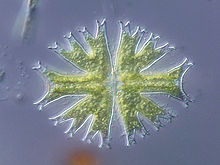
Back دسميديات Arabic دسميديات ARZ Desmidiales AZ Zieralgen German Desmidiales Spanish زنجیرهسانان FA Desmidiales French Desmidiales Croatian Desmidiales Hungarian Դեսմիդներ HY
| Desmids | |
|---|---|

| |
| Micrasterias furcata | |
| Scientific classification | |
| Clade: | Viridiplantae |
| (unranked): | Charophyta |
| Class: | Zygnematophyceae |
| Order: | Desmidiales Bessey[1] |
| Families | |
Desmidiales, commonly called the desmids (Gr. desmos, bond or chain), are an order in the Charophyta, a division of green algae in which the land plants (Embryophyta) emerged.[2] Desmids consist of single-celled (sometimes filamentous or colonial) microscopic green algae. Because desmids are highly symmetrical, attractive, and come in a diversity of forms, they are popular subjects for microscopists, both amateur and professional.[3]
The desmids belong to the class Zygnematophyceae. Although they are sometimes grouped together as a single family Desmidiaceae,[4] most classifications recognize three to five families, usually within their own order, Desmidiales.[5]
The Desmidiales comprise around 40 genera and 5,000[6] to 6,000[7] species, found mostly but not exclusively in fresh water. In general, desmids prefer acidic waters (pH between 4.8 and 7.0), so many species may be found in the fissures between patches of sphagnum moss in marshes.[3] As desmids are sensitive to changes in their environments, they are useful as bioindicators for water and habitat quality.[8]
- ^ Cite error: The named reference
AlgaeBasewas invoked but never defined (see the help page). - ^ Gontcharov AA, Marin BA, Melkonian MA (January 2003). "Molecular phylogeny of conjugating green algae (Zygnemophyceae, Streptophyta) inferred from SSU rDNA sequence comparisons". J. Mol. Evol. 56 (1): 89–104. Bibcode:2003JMolE..56...89G. doi:10.1007/s00239-002-2383-4. PMID 12569426. S2CID 35734083.
- ^ a b Prescott, G. W. (1948). "Desmids". Botanical Review. 14 (10): 644–676. doi:10.1007/BF02861551. JSTOR 4353406.
- ^ Kanetsuna, Y. (2002). "New and interesting desmids (Zygnematales, Chlorophyceae) collected from Asia". Phycological Research. 50 (2): 101–113. doi:10.1046/j.1440-1835.2002.00263.x. S2CID 85054464.
- ^ Cite error: The named reference
Brook 2010was invoked but never defined (see the help page). - ^ Van den Hoek, C., D. G. Mann, & H. M. Jahns, 1995. Algae:An Introduction to Phycology, page 468. (Cambridge: Cambridge University Press). ISBN 0-521-30419-9
- ^ Brook, Alan J., 1981. The Biology of Desmids, page 1. (Berkeley: University of California Press). ISBN 0-520-04281-6
- ^ Coesel, Peter F.M. (2001). "The significance of desmids as indicators of the trophic status of freshwaters". Biodiversity & Conservation. 10: 177–187.